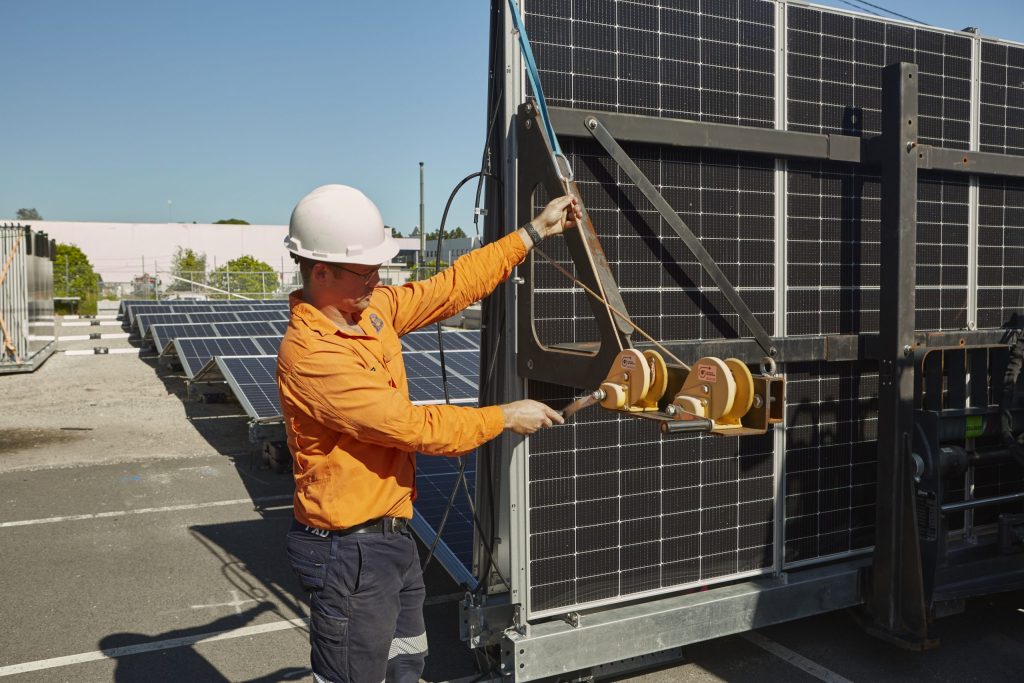Australia’s Renewable Energy Transition – Greenmoxie™
5 min read
Australia has set ambitious renewable energy targets, aiming to achieve net-zero emissions by 2050. This goal is driven by the urgent need to combat climate change and reduce reliance on fossil fuels. The country has made significant strides, with renewable energy sources like wind and solar power contributing an increasing share of the energy mix. However, the transition is not without its challenges, including the need for efficient and cost-effective construction methods.
Prefabrication has emerged as a key strategy in accelerating Australia’s renewable energy transition. By shifting construction tasks from the field to a controlled factory environment, prefabrication offers numerous benefits, including reduced installation time, lower costs, and improved quality control. This article explores the role of prefabrication in renewable energy projects, focusing on its impact on efficiency, risk mitigation, and technological advancements.
Prefabrication in Renewable Energy
Prefabrication, also known as off-site construction, involves assembling components of a structure in a factory before transporting them to the construction site. This method has a long history, dating back to the early 20th century, and has been used in various industries, including housing, commercial buildings, and infrastructure. In the context of renewable energy, prefabrication is particularly relevant for solar energy projects, where large-scale installations can benefit from the streamlined processes and cost savings it offers.
Prefabricated solar systems are pre-assembled and pre-wired in a factory setting, allowing for rapid deployment on-site. This approach not only reduces the time required for installation but also minimises the risk of errors and defects. The benefits of prefabrication extend beyond efficiency and cost savings; it also enhances safety by reducing the need for on-site labour and mitigating risks associated with weather conditions and other environmental factors.
Efficiency Gains in Solar Systems
The use of prefabricated solar systems has led to significant efficiency gains in renewable energy projects. By assembling components in a controlled environment, manufacturers can ensure higher quality and consistency, reducing the likelihood of defects and rework. This results in faster installation times and lower labour costs, making solar energy projects more economically viable.
Data from various projects demonstrate the efficiency gains achieved through prefabrication. For instance, prefabricated solar arrays can be installed in a fraction of the time required for traditional on-site construction. This not only accelerates project timelines but also reduces the overall cost of the project, making renewable energy more competitive with traditional energy sources.
Moreover, prefabrication allows for better utilisation of resources and materials. By standardising components and processes, manufacturers can optimise production and minimise waste. This contributes to the sustainability of renewable energy projects, aligning with Australia’s broader environmental goals.
Mitigating Risks with Prefabrication
One of the key advantages of prefabrication is its ability to mitigate risks associated with on-site construction. Weather delays, labour shortages, and quality control issues are common challenges in traditional construction methods. Prefabrication addresses these challenges by shifting much of the work to a controlled factory environment, where conditions are more predictable and manageable.
For example, weather-related delays can significantly impact the timeline and cost of a project. By assembling components off-site, prefabrication reduces the dependency on favourable weather conditions, ensuring that projects stay on schedule. This is particularly important for large-scale solar installations, where delays can have substantial financial implications.
Labour shortages are another critical issue in the construction industry. Prefabrication reduces the need for on-site labour, allowing projects to proceed even in the face of workforce constraints. This not only ensures timely completion but also enhances safety by reducing the number of workers exposed to potential hazards on-site. Industry professionals have noted the benefits of prefabrication in mitigating these risks, highlighting its role in improving the reliability and efficiency of renewable energy projects.
Innovative Technologies
5B, an Australian company founded by solar engineers Chris McGrath and Eden Tehan, has been at the forefront of leveraging prefabrication in solar energy projects. Their flagship technology, the 5B Maverick, exemplifies the benefits of prefabrication. This accordion-style prefabricated solar array can be quickly deployed by a small crew, significantly reducing installation time and costs.
The 5B Maverick represents a shift in the traditional deployment and construction of solar projects. By pre-assembling and pre-wiring the solar arrays in a factory setting, 5B ensures higher quality control and reduces the likelihood of issues such as faulty connections and dead modules. This approach not only enhances efficiency but also mitigates risks associated with on-site construction.
5B’s commitment to innovation and prefabrication has made clean energy more accessible and competitive. With over 140 project sites worldwide, the company is catalysing a global transition towards sustainable power solutions. Their work underscores the potential of prefabrication to revolutionise the renewable energy sector, making it a key strategy in achieving Australia’s renewable energy goals.
ModularWalls and Construction Efficiency
ModularWalls, a company with over 30 years of experience in composite panelling, has also contributed to enhancing construction efficiency through prefabrication. Their innovative composite panel technology offers a cost-effective and durable alternative to traditional construction materials, making it an ideal choice for renewable energy projects.
The EnduroMax composite panels produced by ModularWalls are strong, lightweight, and virtually maintenance-free. Unlike traditional brick and concrete walls, these panels do not rot, warp, or corrode, ensuring long-term durability and performance. This makes them particularly suitable for harsh and challenging climatic conditions, where traditional materials may fail.
By reducing the high costs and labour associated with masonry and concrete construction, ModularWalls’ products contribute to the overall efficiency and sustainability of renewable energy projects. Their commitment to quality and innovation has positioned them as a key player in the construction industry, supporting the transition to renewable energy through advanced prefabrication techniques.
BlueScope Steel’s Quality Materials
BlueScope Steel, an Australian flat product steel producer, plays a crucial role in supporting prefabrication in the renewable energy sector. The company provides high-quality steel products for prefabricated solar systems, ensuring the structural integrity and durability of these installations.
BlueScope Steel’s products are used in various renewable energy projects, including solar farms and wind turbines. Their metal-coated and painted steel building products, marketed under well-known brands such as LYSAGHT and COLORBOND, offer superior performance and longevity. This makes them an ideal choice for prefabricated solar systems, where reliability and durability are paramount.
The company’s commitment to sustainability and innovation aligns with Australia’s renewable energy goals. By providing high-quality materials for prefabrication, BlueScope Steel supports the efficient and cost-effective deployment of renewable energy projects. Their involvement in the sector underscores the importance of collaboration and quality in achieving a sustainable energy future.
Prefabrication Driving Renewable Energy
Prefabrication has emerged as a powerful catalyst for Australia’s renewable energy transition. By offering efficiency gains, cost savings, and risk mitigation, prefabrication supports the rapid and sustainable deployment of renewable energy projects. Companies like 5B, ModularWalls, and BlueScope Steel are at the forefront of this transformation, leveraging innovative technologies and high-quality materials to drive progress.
The benefits of prefabrication extend beyond individual projects, contributing to the broader goals of reducing emissions and combating climate change. As Australia continues to pursue its renewable energy targets, the role of prefabrication will become increasingly important. Stakeholders in the renewable energy sector are encouraged to consider prefabrication as a key strategy in their projects, harnessing its potential to accelerate the transition to a sustainable energy future.






